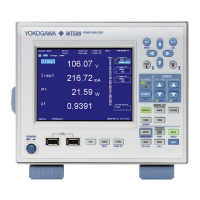4-27
IM 760201-01E
Measurement Conditions
3
2
1
4
5
6
7
8
9
10
11
12
13
14
App
Index
Explanation
For an explanation of the averaging feature, see section 2.3.
The averaging function is effective when reading of the numeric display is difficult due to
fluctuations. This occurs when the fluctuation of the power supply or the load is large or
when the input signal frequency is low.
Measurement Functions Used in Normal Measurement
Turning Averaging On or Off
You can choose whether or not to perform the selected averaging operation.
• ON: The selected averaging operation is performed.
• OFF: The selected averaging operation is not performed.
Selecting the Averaging Type
You can select one of the choices below. For details about the equations used for each
choice, see section 2.3.
•
Exp: Exponential averaging is performed.
• Lin: Linear averaging is performed.
Setting the Attenuation Constant or Average Count
If the averaging type is Exp (exponential averaging), set the attenuation constant. If the
averaging type is Lin (moving averaging), set the average count.
•
Exp: The attenuation constant can be selected from 2, 4, 8, 16, 32, and 64.
• Lin: The average count can be selected from 8, 16, 32, and 64.
Measurement Functions That Are Averaged
The measurement functions that are directly averaged are indicated below. Other
functions that use these functions in their computation are also affected by averaging.
For details about how each measurement function is determined, see appendix 1.
•
Urms, Umn, Udc, Urmn, Uac, Irms, Imn, Idc, Irmn, Iac, P, S, and Q
•
Δ
F1 to
Δ
F4 (on models with the delta computation option)
•
CfU, CfI, WS, WQ,
η
1, and
η
2 are computed using Urms, Irms, P, S, and Q, which are
all averaged.
4.10 Selecting an Averaging Method

